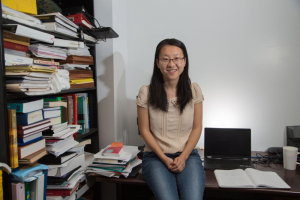In a recent paper published in the journal Nano Letters, mechanical engineers at the UH Cullen College of Engineering describe a novel method for characterizing and understanding the behavior of nanomaterials.
The invention of methods and tools to better understand the behavior of materials is partially responsible for the technological revolution of the 21st century. For instance, understanding the electronic properties of semiconductors led to their utilization as the “brains” of computers, and determining the mechanical behavior of metal alloys made modern aircraft construction possible.
In order to understand why materials behave the way they do, modern researchers recently have taken to using atomistic simulations – that is, modeling a material one atom at a time to unravel the fundamental mechanisms underpinning its physical or chemical behaviors.
But such simulations can only account for phenomena that take place in under a few nanoseconds. By comparison, the blink of your eyes takes about a second, or roughly 1 million nanoseconds. This time-scale limitation precludes atomistic simulations from revealing what’s happening when a material is stretched or deformed slowly, among many more phenomena. Studying how materials – especially nano-sized materials – will react under mechanical stress in real-life applications or even during laboratory tests was impossible until now.
Doctoral student Xin Yan used a suite of algorithms that collectively provide some resolution to the time limitations of atomistic simulations. Guided by intuition and “an enormous body of excellent past work,” Yan said she deployed an algorithm suite to simulate what happens at the microscopic level when a nanomaterial is slowly compressed. Under the guidance of her adviser Pradeep Sharma, professor and chair of the mechanical engineering department at the Cullen College, Yan studied the behavior of a nano-sized pillars of nickel made up of only a few hundred atoms.
Traditional atomistic simulations have shown that when nickel nano-pillars experience a fast application of force, the length of the pillar will simply shorten, much like a rubber eraser would if you pushed down on it. When studied using Yan’s models, her simulations revealed that the nano-pillars actually behave more like a liquid when slowly squeezed.
“The nano-pillar behaved like a soft, mushy blob being squished, with material oozing out in ugly spirals – or beautiful spirals, depending on your vantage view,” said Yan.
Experiments using electron microscopes to observe the behavior of nanostructures have confirmed the same liquid-like deformation when the materials undergo slow mechanical stress.
“Time-scaling is a very hard problem and may be considered the ‘Holy Grail’ of computational materials science,” Yan said.
Although the computational methodology that Yan and Sharma deployed provides interesting insights into the behavior of nanostructures undergoing slow mechanical deformation, the researchers said a complete resolution to the time-scale bottleneck remains elusive. However, the novel method represents another step towards the creation of materials with never-before-seen applications.
“Such computer simulations provide a unique window into the behavior of materials at the microscopic level and provides us with clues for how to design next-generation materials with brand new applications,” said Yan.
The research published in Nano Letters was initially funded by a grant from the Air Force Office of Scientific Research (AFOSR) and is partially funded by the National Science Foundation (NSF).
To view the full paper, please visit https://pubs.acs.org/doi/abs/10.1021/acs.nanolett.6b00117
